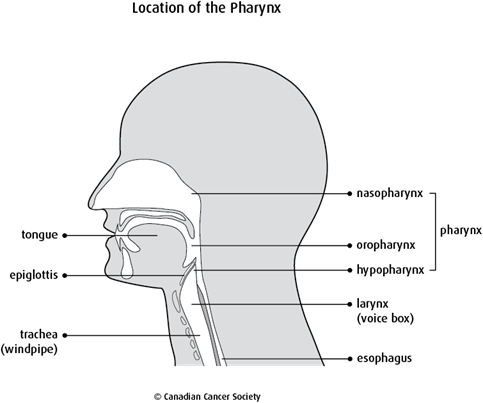The pharynx
The pharynx is commonly called the throat. It is a passageway in the head and neck that is part of both the digestive system and the respiratory system. The pharynx connects the nose, mouth and throat to each other.

Structure of the pharynx
The pharynx is a hollow, muscular tube that is about 13 cm (5 in) long. It starts behind the nose and goes past the back of the mouth, down the neck and behind the larynx (voice box). The lowest part of the pharynx joins the tube that connects the pharynx to the stomach (called the esophagus).
The pharynx is divided into 3 parts called the nasopharynx, oropharynx and hypopharynx.
Nasopharynx
The nasopharynx is the upper part of the pharynx. It is connected to the nose and is separated from the mouth by the soft area at the back of the roof of the mouth (called the soft palate). The base of the skull forms the top of the nasopharynx. The upper part of the pharyngeal wall forms the sides and back of the nasopharynx. The nasopharynx is lined by a thin layer of epithelial cells (called the respiratory epithelium or ciliated columnar epithelium).
The nasopharynx is connected to the middle part of each ear by the Eustachian tubes. These tubes have openings on each side of the nasopharynx.
The adenoid (pharyngeal tonsil) is a mass of lymphatic tissue found on the back wall of the nasopharynx.
Oropharynx
The oropharynx is the middle part of the pharynx. It starts at the soft palate and goes down to the back (base) of the tongue. The oropharynx ends at the epiglottis (the flap of moveable cartilage that closes the larynx when you swallow). The oropharynx includes the base of the tongue, tonsils, soft palate and middle part of the pharyngeal wall. It also includes the small flap of tissue that hangs down at the back of the mouth (called the uvula). The oropharynx is lined by flat, thin cells called squamous cells.
Hypopharynx
The hypopharynx is the lower part of the pharynx. It is also called the laryngopharynx. It starts at the epiglottis and goes down to the top of the esophagus. The hypopharynx is behind and on each side of the larynx.
The hypopharynx includes the 2 small grooves in the pharyngeal wall on either side of the opening into the larynx (called the piriform sinuses). It also includes the lower part of the pharyngeal wall as well as the post-cricoid area, which is just behind the cricoid cartilage of the larynx. The hypopharynx is lined by squamous cells.
What the pharynx does
The pharynx allows you to swallow, breathe and speak.
Swallowing
The oropharynx is a passageway for food that you swallow. The walls of the oropharynx and hypopharynx have muscles that help move food from the mouth to the esophagus.
Breathing
The nasopharynx allows air to flow from the nose through the rest of the pharynx, larynx and trachea (windpipe) and then into the lungs.
Speaking
When you speak, the muscles and the walls of the pharynx vibrate as air is forced from the larynx. These vibrations are turned into sounds by the mouth, lips and tongue.
Other parts of the head and neck
There are many important structures in the head and neck. The pharynx is close to these structures, so pharyngeal cancers and their treatments can affect them.
Cervical lymph nodes
Lymph nodes are small, bean-shaped masses of lymphatic tissue that sit along the lymph vessels. Lymph is a clear fluid that contains lymphocytes (a type of white blood cell that fights germs, foreign substances or cancer cells). Lymph vessels carry lymph fluid to lymph nodes throughout the body. Lymph nodes store lymphocytes and filter bacteria and foreign substances (including cancer cells) from lymph.
The lymph nodes in the neck are called cervical lymph nodes. There are many cervical lymph nodes, including some around the pharynx. The cervical lymph nodes are grouped into different groups (called levels) depending on their location in the neck. There are 6 levels of cervical lymph nodes on each side of the neck.
Cranial nerves
The cranial nerves control many functions in the head and neck, such as swallowing, vision, hearing and eye movement. Some cranial nerves are found in the tissues around the pharynx.
Sometimes a tumour in the pharynx can spread to the cranial nerves. If the cranial nerves are in the treatment area, your healthcare team will try to protect these nerves as much as possible. But sometimes a pharyngeal tumour or its treatments can damage the cranial nerves and lead to temporary or permanent side effects.
Your trusted source for accurate cancer information
With support from readers like you, we can continue to provide the highest quality cancer information for over 100 types of cancer.
We’re here to ensure easy access to accurate cancer information for you and the millions of people who visit this website every year. But we can’t do it alone.
Every donation helps fund reliable cancer information, compassionate support services and the most promising research. Please give today because every contribution counts. Thank you.
